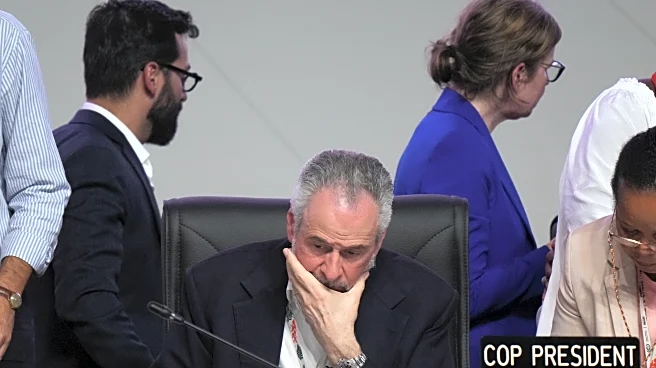What's Happening?
The COP30 climate summit held in Belem, Brazil, concluded with an agreement among 80 countries to increase financing for poorer nations affected by climate change. However, the deal has been criticized
for its lack of measures to curb planet-warming emissions, particularly in the fashion industry. The agreement did not address fossil fuels and shifted focus from mitigation to adaptation, promising $120 billion annually by 2035 for climate adaptation, a delay from the original 2030 goal. The fashion industry, heavily reliant on supply chains in climate-vulnerable countries, faces challenges as workers suffer from heat stress in factories. The UN Fashion Industry Charter for Climate Action called for accelerated renewable energy access and corporate climate reporting, but critics argue that fashion's emissions could reach 1.24 billion tonnes of CO2 by 2030 without binding commitments.
Why It's Important?
The fashion industry is a significant contributor to global emissions, and the COP30 agreement's shortcomings highlight the urgent need for industry-specific climate action. The reliance on workers in countries like Bangladesh and Vietnam, where climate impacts are severe, underscores the vulnerability of fashion's supply chains. The industry's dependence on fossil-fuel-based synthetics and animal agriculture further complicates its environmental footprint. The lack of binding commitments from the UN and the industry's slow progress on climate goals pose risks to both workers and business margins. As sustainability becomes less prioritized amid economic uncertainties, the industry must address its climate risks proactively to avoid long-term damage.
What's Next?
The fashion industry must accelerate its efforts to reduce emissions and adapt to climate impacts. Brands are urged to focus on renewable energy access and corporate climate reporting to meet emissions-reduction targets. The industry faces pressure to phase out coal and improve supply chain resilience. Climate groups continue to advocate for stronger commitments and the inclusion of workers in climate plans. As the industry grapples with economic challenges, it must balance short-term performance with long-term sustainability goals. The need for financing remains a hurdle, and stakeholders must collaborate to drive meaningful change.
Beyond the Headlines
The COP30 agreement's failure to address deforestation protections poses risks to fashion's leather supply chains, highlighting the industry's complex relationship with environmental issues. The mixed outcomes of the summit emphasize the need for fashion to look beyond high-level proclamations and implement tangible actions. Ethical considerations arise as garment workers face extreme heat and climate instability, demanding a more inclusive approach to climate planning. The industry's focus on mitigation over adaptation may hinder progress, and stakeholders must prioritize worker welfare alongside environmental goals.












